The American Civil Rights Movement: Goals, Figures, and Legacy
VerifiedAdded on 2021/04/24
|15
|4288
|42
Essay
AI Summary
This essay provides a comprehensive overview of the American Civil Rights Movement, a pivotal social movement of the 20th century. It explores the historical context, including slavery and racial discrimination, which fueled the movement. The essay details the objectives and goals, such as ending segregation and securing equal rights for African Americans, and highlights key figures like Dr. Martin Luther King Jr. and Malcolm X. It analyzes significant events like the Montgomery Bus Boycott, the Selma March, and the March on Washington, and discusses the movement's achievements, including the Civil Rights Act of 1964 and the Voting Rights Act of 1965. The essay also examines the legacy of the movement, its impact on American society, and the current conditions of the Black community. The influence of international inspirations, like Gandhi's non-violent methods, is also discussed. Overall, the essay provides a thorough examination of the movement's origins, key figures, accomplishments, and lasting impact on American society.

Running head: A PROTEST THAT CHANGED AMRERICA
A PROTEST THAT CHANGED AMRERICA
Name of the Student
Name of the University
Author note
A PROTEST THAT CHANGED AMRERICA
Name of the Student
Name of the University
Author note
Paraphrase This Document
Need a fresh take? Get an instant paraphrase of this document with our AI Paraphraser
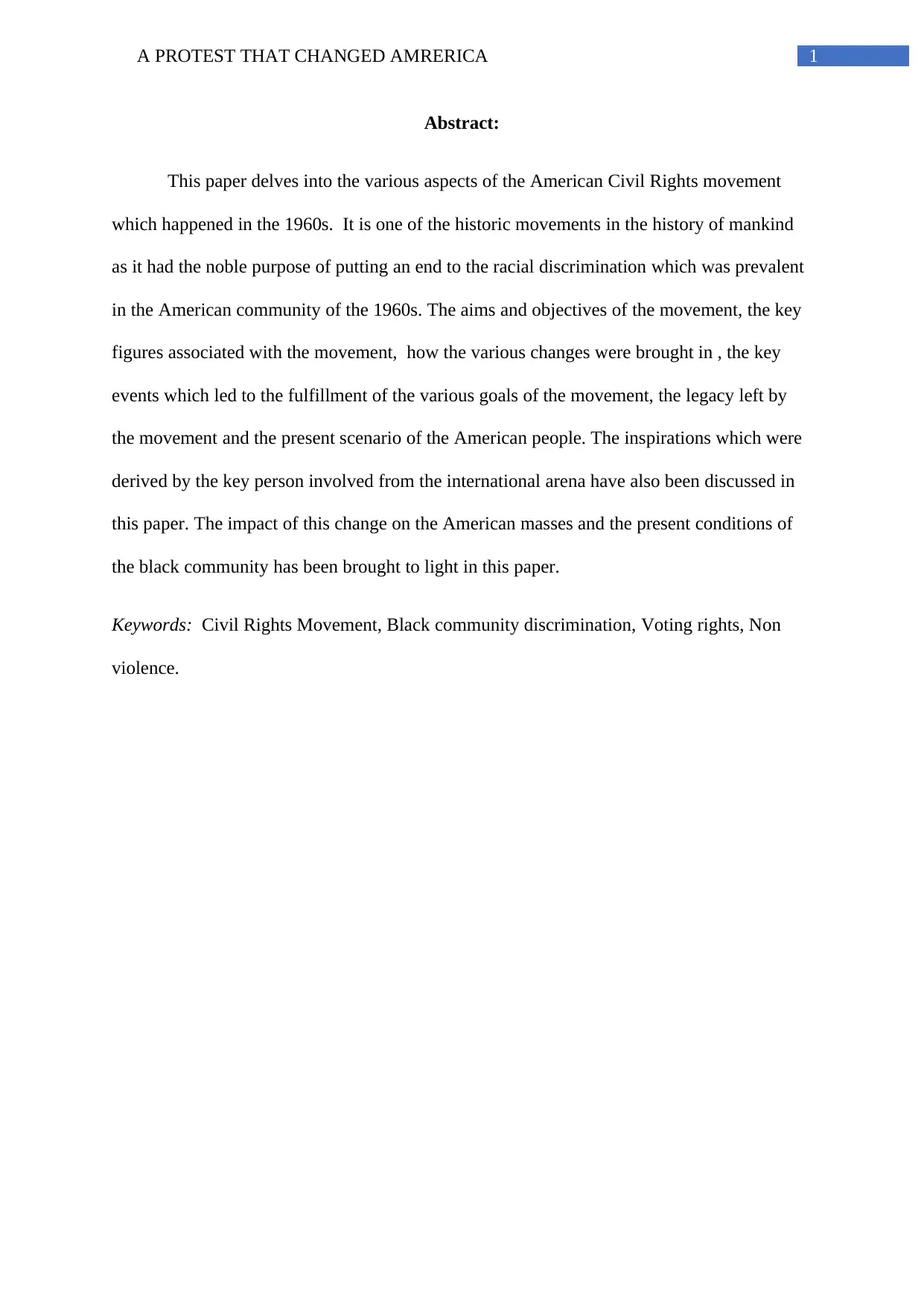
1A PROTEST THAT CHANGED AMRERICA
Abstract:
This paper delves into the various aspects of the American Civil Rights movement
which happened in the 1960s. It is one of the historic movements in the history of mankind
as it had the noble purpose of putting an end to the racial discrimination which was prevalent
in the American community of the 1960s. The aims and objectives of the movement, the key
figures associated with the movement, how the various changes were brought in , the key
events which led to the fulfillment of the various goals of the movement, the legacy left by
the movement and the present scenario of the American people. The inspirations which were
derived by the key person involved from the international arena have also been discussed in
this paper. The impact of this change on the American masses and the present conditions of
the black community has been brought to light in this paper.
Keywords: Civil Rights Movement, Black community discrimination, Voting rights, Non
violence.
Abstract:
This paper delves into the various aspects of the American Civil Rights movement
which happened in the 1960s. It is one of the historic movements in the history of mankind
as it had the noble purpose of putting an end to the racial discrimination which was prevalent
in the American community of the 1960s. The aims and objectives of the movement, the key
figures associated with the movement, how the various changes were brought in , the key
events which led to the fulfillment of the various goals of the movement, the legacy left by
the movement and the present scenario of the American people. The inspirations which were
derived by the key person involved from the international arena have also been discussed in
this paper. The impact of this change on the American masses and the present conditions of
the black community has been brought to light in this paper.
Keywords: Civil Rights Movement, Black community discrimination, Voting rights, Non
violence.
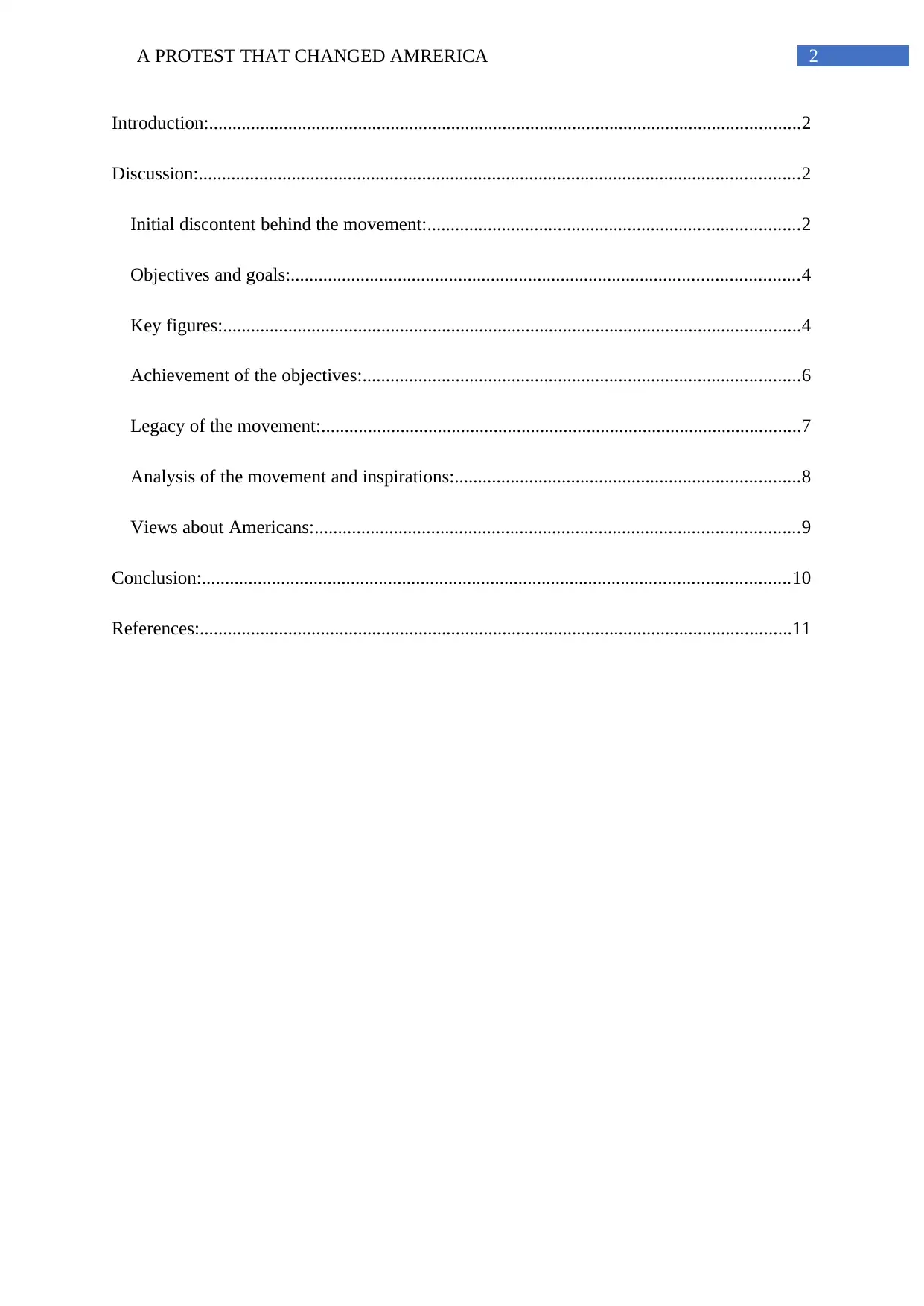
2A PROTEST THAT CHANGED AMRERICA
Introduction:...............................................................................................................................2
Discussion:.................................................................................................................................2
Initial discontent behind the movement:................................................................................2
Objectives and goals:.............................................................................................................4
Key figures:............................................................................................................................4
Achievement of the objectives:..............................................................................................6
Legacy of the movement:.......................................................................................................7
Analysis of the movement and inspirations:..........................................................................8
Views about Americans:........................................................................................................9
Conclusion:..............................................................................................................................10
References:...............................................................................................................................11
Introduction:...............................................................................................................................2
Discussion:.................................................................................................................................2
Initial discontent behind the movement:................................................................................2
Objectives and goals:.............................................................................................................4
Key figures:............................................................................................................................4
Achievement of the objectives:..............................................................................................6
Legacy of the movement:.......................................................................................................7
Analysis of the movement and inspirations:..........................................................................8
Views about Americans:........................................................................................................9
Conclusion:..............................................................................................................................10
References:...............................................................................................................................11
⊘ This is a preview!⊘
Do you want full access?
Subscribe today to unlock all pages.

Trusted by 1+ million students worldwide
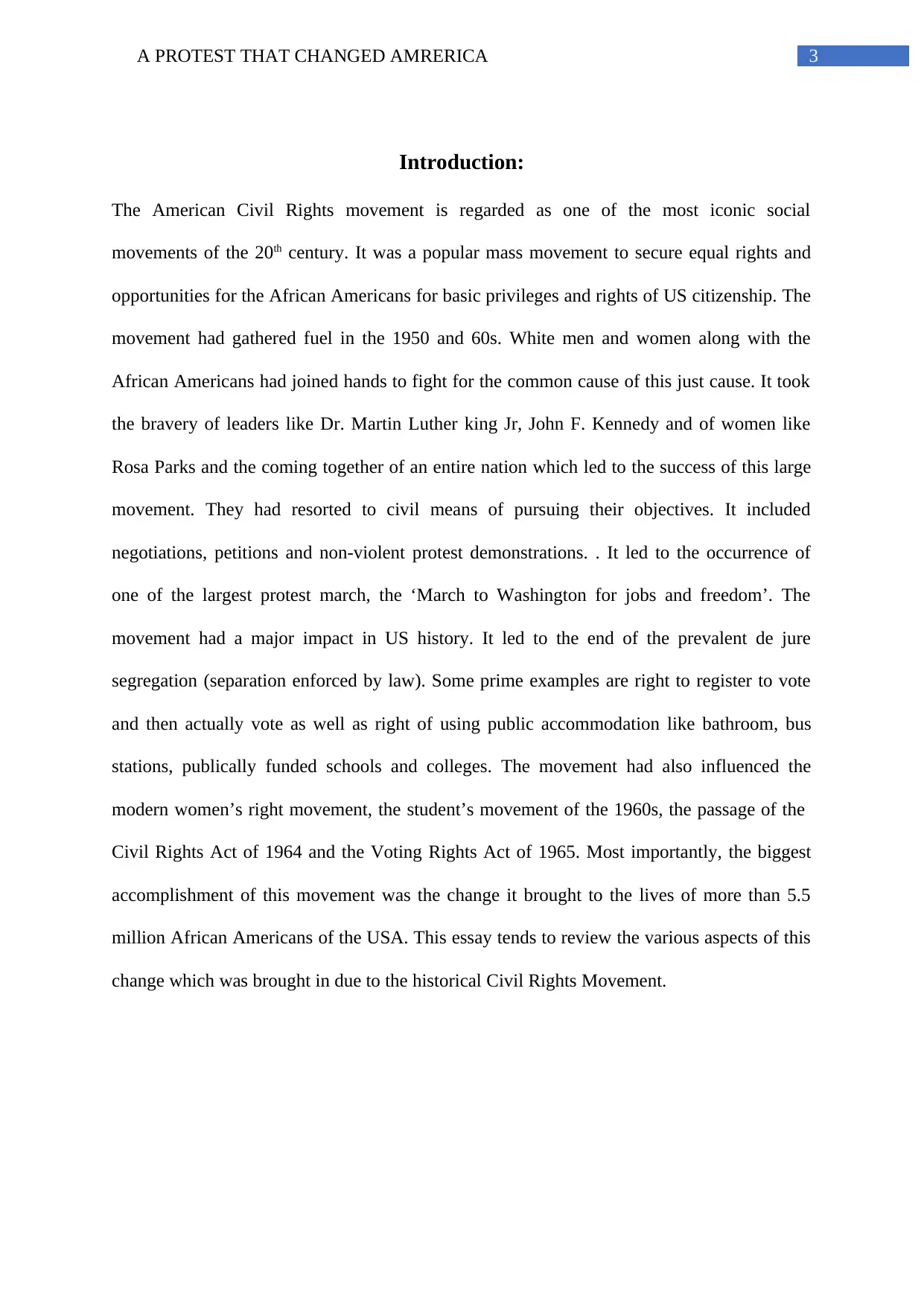
3A PROTEST THAT CHANGED AMRERICA
Introduction:
The American Civil Rights movement is regarded as one of the most iconic social
movements of the 20th century. It was a popular mass movement to secure equal rights and
opportunities for the African Americans for basic privileges and rights of US citizenship. The
movement had gathered fuel in the 1950 and 60s. White men and women along with the
African Americans had joined hands to fight for the common cause of this just cause. It took
the bravery of leaders like Dr. Martin Luther king Jr, John F. Kennedy and of women like
Rosa Parks and the coming together of an entire nation which led to the success of this large
movement. They had resorted to civil means of pursuing their objectives. It included
negotiations, petitions and non-violent protest demonstrations. . It led to the occurrence of
one of the largest protest march, the ‘March to Washington for jobs and freedom’. The
movement had a major impact in US history. It led to the end of the prevalent de jure
segregation (separation enforced by law). Some prime examples are right to register to vote
and then actually vote as well as right of using public accommodation like bathroom, bus
stations, publically funded schools and colleges. The movement had also influenced the
modern women’s right movement, the student’s movement of the 1960s, the passage of the
Civil Rights Act of 1964 and the Voting Rights Act of 1965. Most importantly, the biggest
accomplishment of this movement was the change it brought to the lives of more than 5.5
million African Americans of the USA. This essay tends to review the various aspects of this
change which was brought in due to the historical Civil Rights Movement.
Introduction:
The American Civil Rights movement is regarded as one of the most iconic social
movements of the 20th century. It was a popular mass movement to secure equal rights and
opportunities for the African Americans for basic privileges and rights of US citizenship. The
movement had gathered fuel in the 1950 and 60s. White men and women along with the
African Americans had joined hands to fight for the common cause of this just cause. It took
the bravery of leaders like Dr. Martin Luther king Jr, John F. Kennedy and of women like
Rosa Parks and the coming together of an entire nation which led to the success of this large
movement. They had resorted to civil means of pursuing their objectives. It included
negotiations, petitions and non-violent protest demonstrations. . It led to the occurrence of
one of the largest protest march, the ‘March to Washington for jobs and freedom’. The
movement had a major impact in US history. It led to the end of the prevalent de jure
segregation (separation enforced by law). Some prime examples are right to register to vote
and then actually vote as well as right of using public accommodation like bathroom, bus
stations, publically funded schools and colleges. The movement had also influenced the
modern women’s right movement, the student’s movement of the 1960s, the passage of the
Civil Rights Act of 1964 and the Voting Rights Act of 1965. Most importantly, the biggest
accomplishment of this movement was the change it brought to the lives of more than 5.5
million African Americans of the USA. This essay tends to review the various aspects of this
change which was brought in due to the historical Civil Rights Movement.
Paraphrase This Document
Need a fresh take? Get an instant paraphrase of this document with our AI Paraphraser
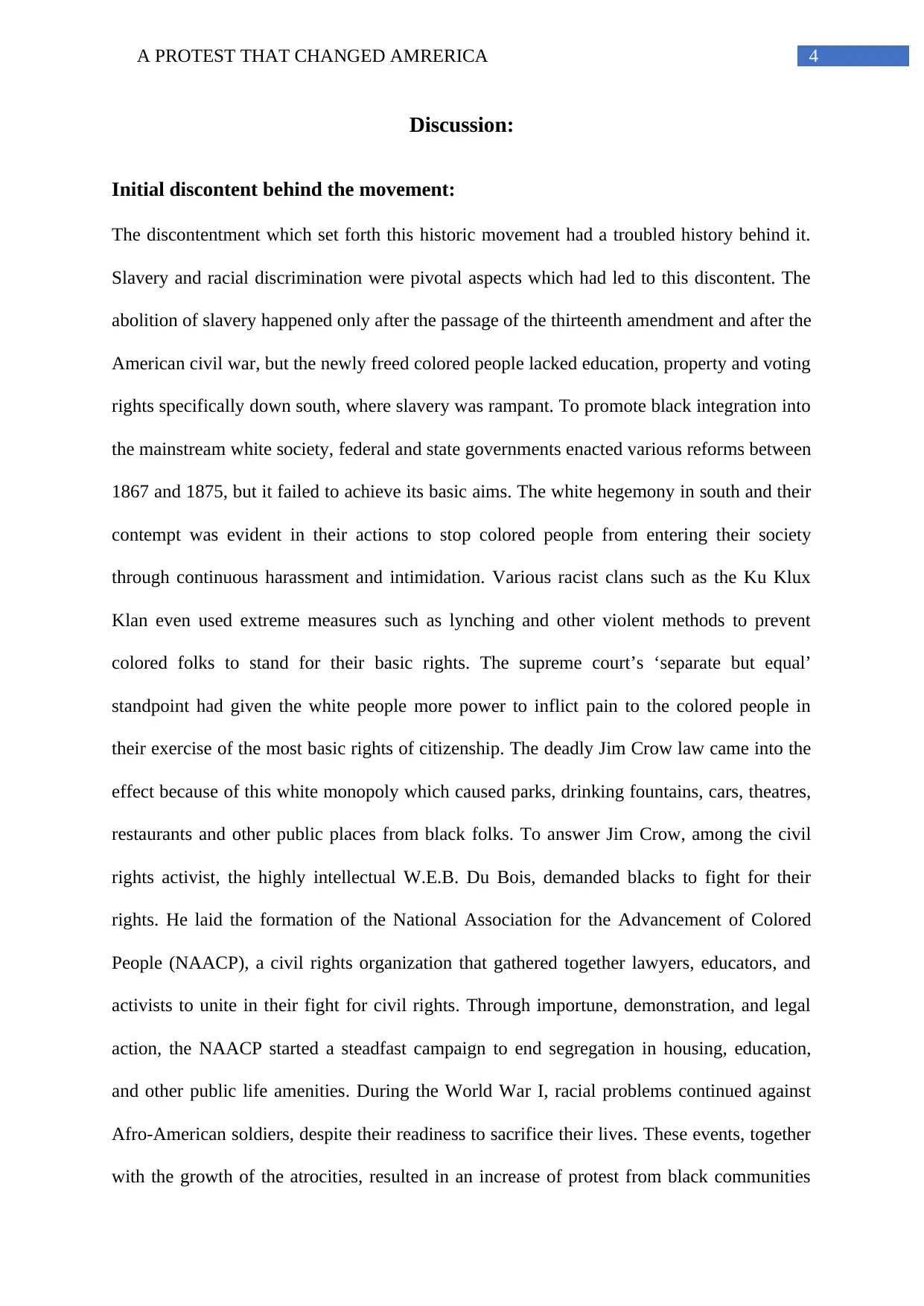
4A PROTEST THAT CHANGED AMRERICA
Discussion:
Initial discontent behind the movement:
The discontentment which set forth this historic movement had a troubled history behind it.
Slavery and racial discrimination were pivotal aspects which had led to this discontent. The
abolition of slavery happened only after the passage of the thirteenth amendment and after the
American civil war, but the newly freed colored people lacked education, property and voting
rights specifically down south, where slavery was rampant. To promote black integration into
the mainstream white society, federal and state governments enacted various reforms between
1867 and 1875, but it failed to achieve its basic aims. The white hegemony in south and their
contempt was evident in their actions to stop colored people from entering their society
through continuous harassment and intimidation. Various racist clans such as the Ku Klux
Klan even used extreme measures such as lynching and other violent methods to prevent
colored folks to stand for their basic rights. The supreme court’s ‘separate but equal’
standpoint had given the white people more power to inflict pain to the colored people in
their exercise of the most basic rights of citizenship. The deadly Jim Crow law came into the
effect because of this white monopoly which caused parks, drinking fountains, cars, theatres,
restaurants and other public places from black folks. To answer Jim Crow, among the civil
rights activist, the highly intellectual W.E.B. Du Bois, demanded blacks to fight for their
rights. He laid the formation of the National Association for the Advancement of Colored
People (NAACP), a civil rights organization that gathered together lawyers, educators, and
activists to unite in their fight for civil rights. Through importune, demonstration, and legal
action, the NAACP started a steadfast campaign to end segregation in housing, education,
and other public life amenities. During the World War I, racial problems continued against
Afro-American soldiers, despite their readiness to sacrifice their lives. These events, together
with the growth of the atrocities, resulted in an increase of protest from black communities
Discussion:
Initial discontent behind the movement:
The discontentment which set forth this historic movement had a troubled history behind it.
Slavery and racial discrimination were pivotal aspects which had led to this discontent. The
abolition of slavery happened only after the passage of the thirteenth amendment and after the
American civil war, but the newly freed colored people lacked education, property and voting
rights specifically down south, where slavery was rampant. To promote black integration into
the mainstream white society, federal and state governments enacted various reforms between
1867 and 1875, but it failed to achieve its basic aims. The white hegemony in south and their
contempt was evident in their actions to stop colored people from entering their society
through continuous harassment and intimidation. Various racist clans such as the Ku Klux
Klan even used extreme measures such as lynching and other violent methods to prevent
colored folks to stand for their basic rights. The supreme court’s ‘separate but equal’
standpoint had given the white people more power to inflict pain to the colored people in
their exercise of the most basic rights of citizenship. The deadly Jim Crow law came into the
effect because of this white monopoly which caused parks, drinking fountains, cars, theatres,
restaurants and other public places from black folks. To answer Jim Crow, among the civil
rights activist, the highly intellectual W.E.B. Du Bois, demanded blacks to fight for their
rights. He laid the formation of the National Association for the Advancement of Colored
People (NAACP), a civil rights organization that gathered together lawyers, educators, and
activists to unite in their fight for civil rights. Through importune, demonstration, and legal
action, the NAACP started a steadfast campaign to end segregation in housing, education,
and other public life amenities. During the World War I, racial problems continued against
Afro-American soldiers, despite their readiness to sacrifice their lives. These events, together
with the growth of the atrocities, resulted in an increase of protest from black communities
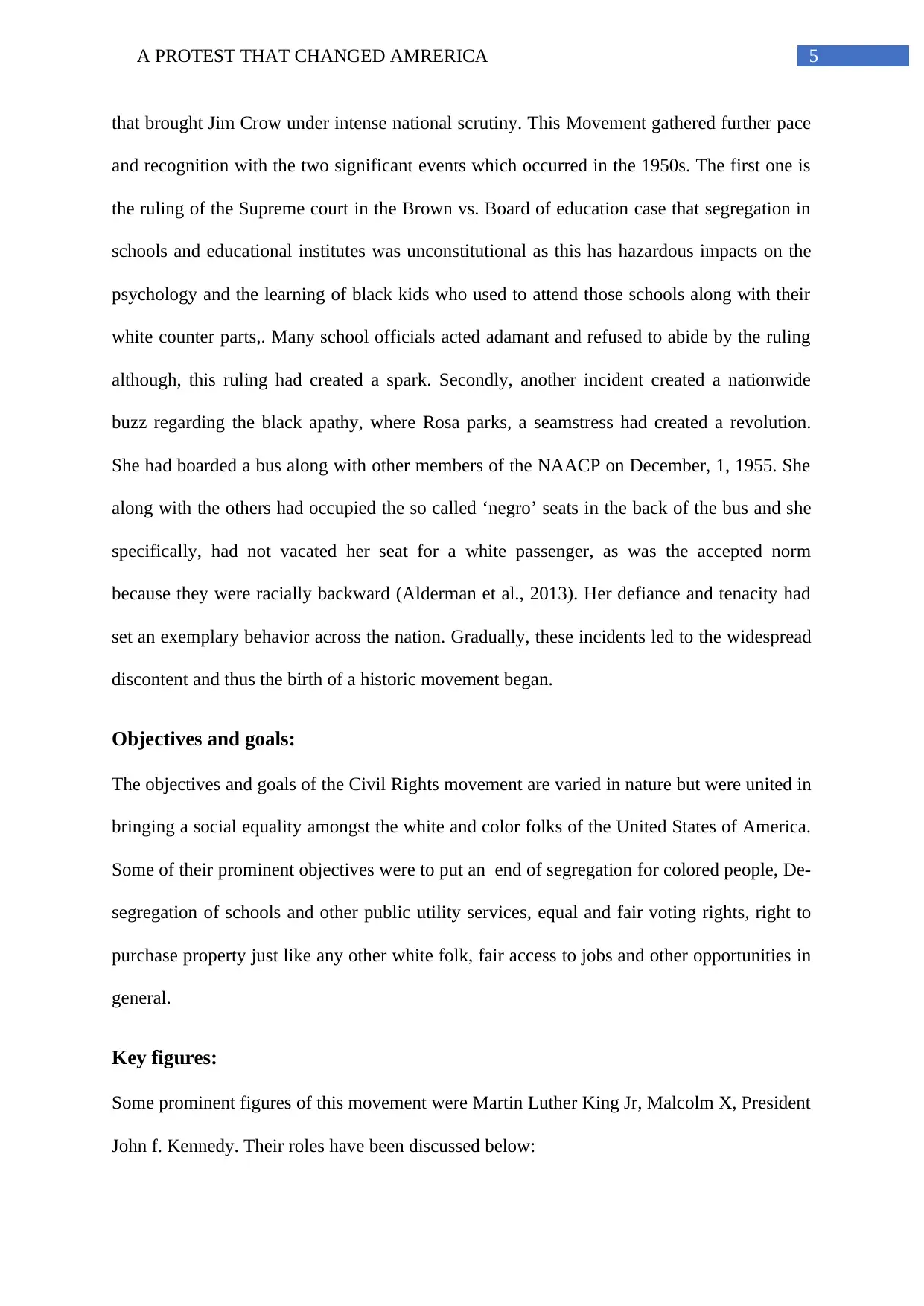
5A PROTEST THAT CHANGED AMRERICA
that brought Jim Crow under intense national scrutiny. This Movement gathered further pace
and recognition with the two significant events which occurred in the 1950s. The first one is
the ruling of the Supreme court in the Brown vs. Board of education case that segregation in
schools and educational institutes was unconstitutional as this has hazardous impacts on the
psychology and the learning of black kids who used to attend those schools along with their
white counter parts,. Many school officials acted adamant and refused to abide by the ruling
although, this ruling had created a spark. Secondly, another incident created a nationwide
buzz regarding the black apathy, where Rosa parks, a seamstress had created a revolution.
She had boarded a bus along with other members of the NAACP on December, 1, 1955. She
along with the others had occupied the so called ‘negro’ seats in the back of the bus and she
specifically, had not vacated her seat for a white passenger, as was the accepted norm
because they were racially backward (Alderman et al., 2013). Her defiance and tenacity had
set an exemplary behavior across the nation. Gradually, these incidents led to the widespread
discontent and thus the birth of a historic movement began.
Objectives and goals:
The objectives and goals of the Civil Rights movement are varied in nature but were united in
bringing a social equality amongst the white and color folks of the United States of America.
Some of their prominent objectives were to put an end of segregation for colored people, De-
segregation of schools and other public utility services, equal and fair voting rights, right to
purchase property just like any other white folk, fair access to jobs and other opportunities in
general.
Key figures:
Some prominent figures of this movement were Martin Luther King Jr, Malcolm X, President
John f. Kennedy. Their roles have been discussed below:
that brought Jim Crow under intense national scrutiny. This Movement gathered further pace
and recognition with the two significant events which occurred in the 1950s. The first one is
the ruling of the Supreme court in the Brown vs. Board of education case that segregation in
schools and educational institutes was unconstitutional as this has hazardous impacts on the
psychology and the learning of black kids who used to attend those schools along with their
white counter parts,. Many school officials acted adamant and refused to abide by the ruling
although, this ruling had created a spark. Secondly, another incident created a nationwide
buzz regarding the black apathy, where Rosa parks, a seamstress had created a revolution.
She had boarded a bus along with other members of the NAACP on December, 1, 1955. She
along with the others had occupied the so called ‘negro’ seats in the back of the bus and she
specifically, had not vacated her seat for a white passenger, as was the accepted norm
because they were racially backward (Alderman et al., 2013). Her defiance and tenacity had
set an exemplary behavior across the nation. Gradually, these incidents led to the widespread
discontent and thus the birth of a historic movement began.
Objectives and goals:
The objectives and goals of the Civil Rights movement are varied in nature but were united in
bringing a social equality amongst the white and color folks of the United States of America.
Some of their prominent objectives were to put an end of segregation for colored people, De-
segregation of schools and other public utility services, equal and fair voting rights, right to
purchase property just like any other white folk, fair access to jobs and other opportunities in
general.
Key figures:
Some prominent figures of this movement were Martin Luther King Jr, Malcolm X, President
John f. Kennedy. Their roles have been discussed below:
⊘ This is a preview!⊘
Do you want full access?
Subscribe today to unlock all pages.

Trusted by 1+ million students worldwide
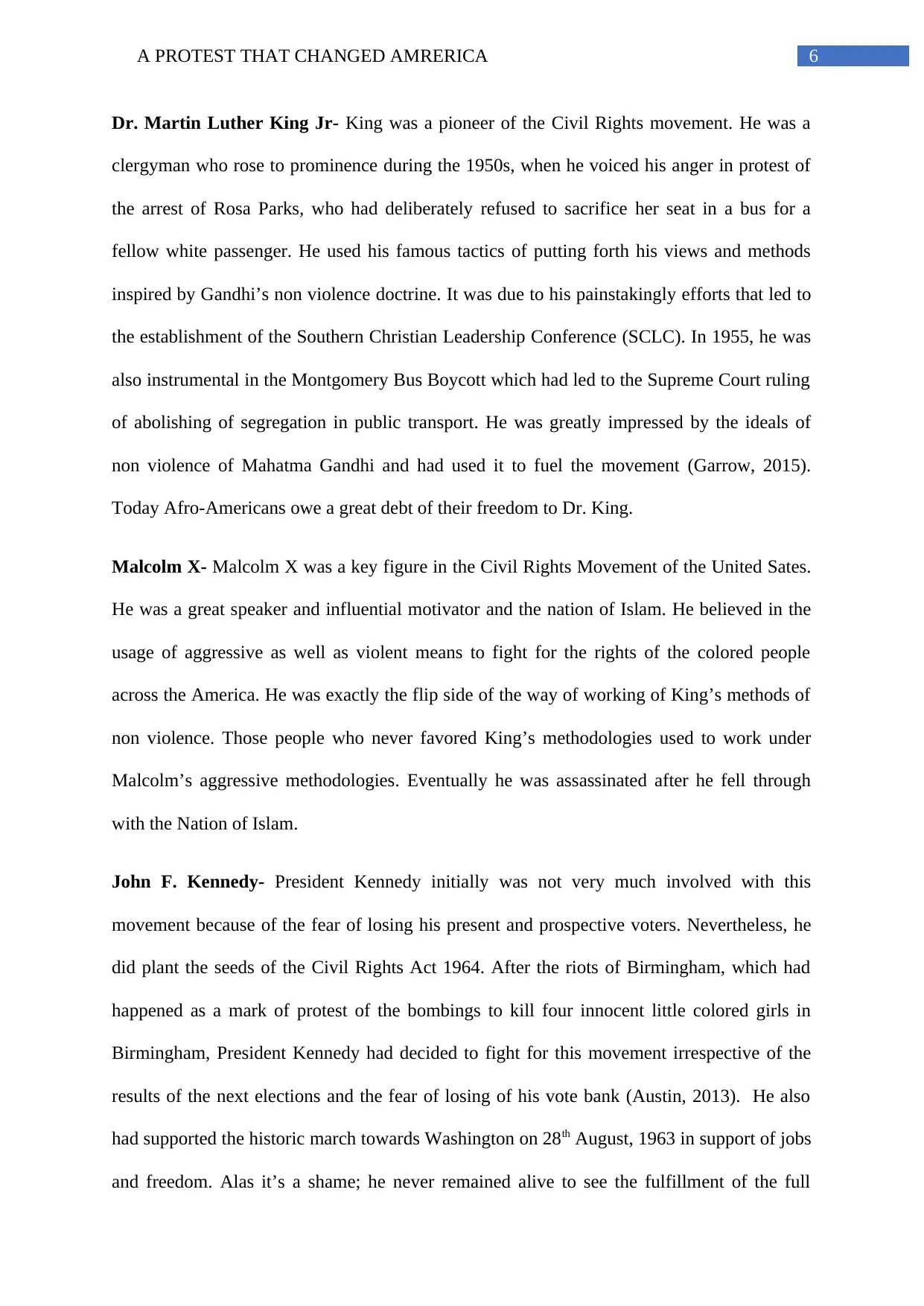
6A PROTEST THAT CHANGED AMRERICA
Dr. Martin Luther King Jr- King was a pioneer of the Civil Rights movement. He was a
clergyman who rose to prominence during the 1950s, when he voiced his anger in protest of
the arrest of Rosa Parks, who had deliberately refused to sacrifice her seat in a bus for a
fellow white passenger. He used his famous tactics of putting forth his views and methods
inspired by Gandhi’s non violence doctrine. It was due to his painstakingly efforts that led to
the establishment of the Southern Christian Leadership Conference (SCLC). In 1955, he was
also instrumental in the Montgomery Bus Boycott which had led to the Supreme Court ruling
of abolishing of segregation in public transport. He was greatly impressed by the ideals of
non violence of Mahatma Gandhi and had used it to fuel the movement (Garrow, 2015).
Today Afro-Americans owe a great debt of their freedom to Dr. King.
Malcolm X- Malcolm X was a key figure in the Civil Rights Movement of the United Sates.
He was a great speaker and influential motivator and the nation of Islam. He believed in the
usage of aggressive as well as violent means to fight for the rights of the colored people
across the America. He was exactly the flip side of the way of working of King’s methods of
non violence. Those people who never favored King’s methodologies used to work under
Malcolm’s aggressive methodologies. Eventually he was assassinated after he fell through
with the Nation of Islam.
John F. Kennedy- President Kennedy initially was not very much involved with this
movement because of the fear of losing his present and prospective voters. Nevertheless, he
did plant the seeds of the Civil Rights Act 1964. After the riots of Birmingham, which had
happened as a mark of protest of the bombings to kill four innocent little colored girls in
Birmingham, President Kennedy had decided to fight for this movement irrespective of the
results of the next elections and the fear of losing of his vote bank (Austin, 2013). He also
had supported the historic march towards Washington on 28th August, 1963 in support of jobs
and freedom. Alas it’s a shame; he never remained alive to see the fulfillment of the full
Dr. Martin Luther King Jr- King was a pioneer of the Civil Rights movement. He was a
clergyman who rose to prominence during the 1950s, when he voiced his anger in protest of
the arrest of Rosa Parks, who had deliberately refused to sacrifice her seat in a bus for a
fellow white passenger. He used his famous tactics of putting forth his views and methods
inspired by Gandhi’s non violence doctrine. It was due to his painstakingly efforts that led to
the establishment of the Southern Christian Leadership Conference (SCLC). In 1955, he was
also instrumental in the Montgomery Bus Boycott which had led to the Supreme Court ruling
of abolishing of segregation in public transport. He was greatly impressed by the ideals of
non violence of Mahatma Gandhi and had used it to fuel the movement (Garrow, 2015).
Today Afro-Americans owe a great debt of their freedom to Dr. King.
Malcolm X- Malcolm X was a key figure in the Civil Rights Movement of the United Sates.
He was a great speaker and influential motivator and the nation of Islam. He believed in the
usage of aggressive as well as violent means to fight for the rights of the colored people
across the America. He was exactly the flip side of the way of working of King’s methods of
non violence. Those people who never favored King’s methodologies used to work under
Malcolm’s aggressive methodologies. Eventually he was assassinated after he fell through
with the Nation of Islam.
John F. Kennedy- President Kennedy initially was not very much involved with this
movement because of the fear of losing his present and prospective voters. Nevertheless, he
did plant the seeds of the Civil Rights Act 1964. After the riots of Birmingham, which had
happened as a mark of protest of the bombings to kill four innocent little colored girls in
Birmingham, President Kennedy had decided to fight for this movement irrespective of the
results of the next elections and the fear of losing of his vote bank (Austin, 2013). He also
had supported the historic march towards Washington on 28th August, 1963 in support of jobs
and freedom. Alas it’s a shame; he never remained alive to see the fulfillment of the full
Paraphrase This Document
Need a fresh take? Get an instant paraphrase of this document with our AI Paraphraser
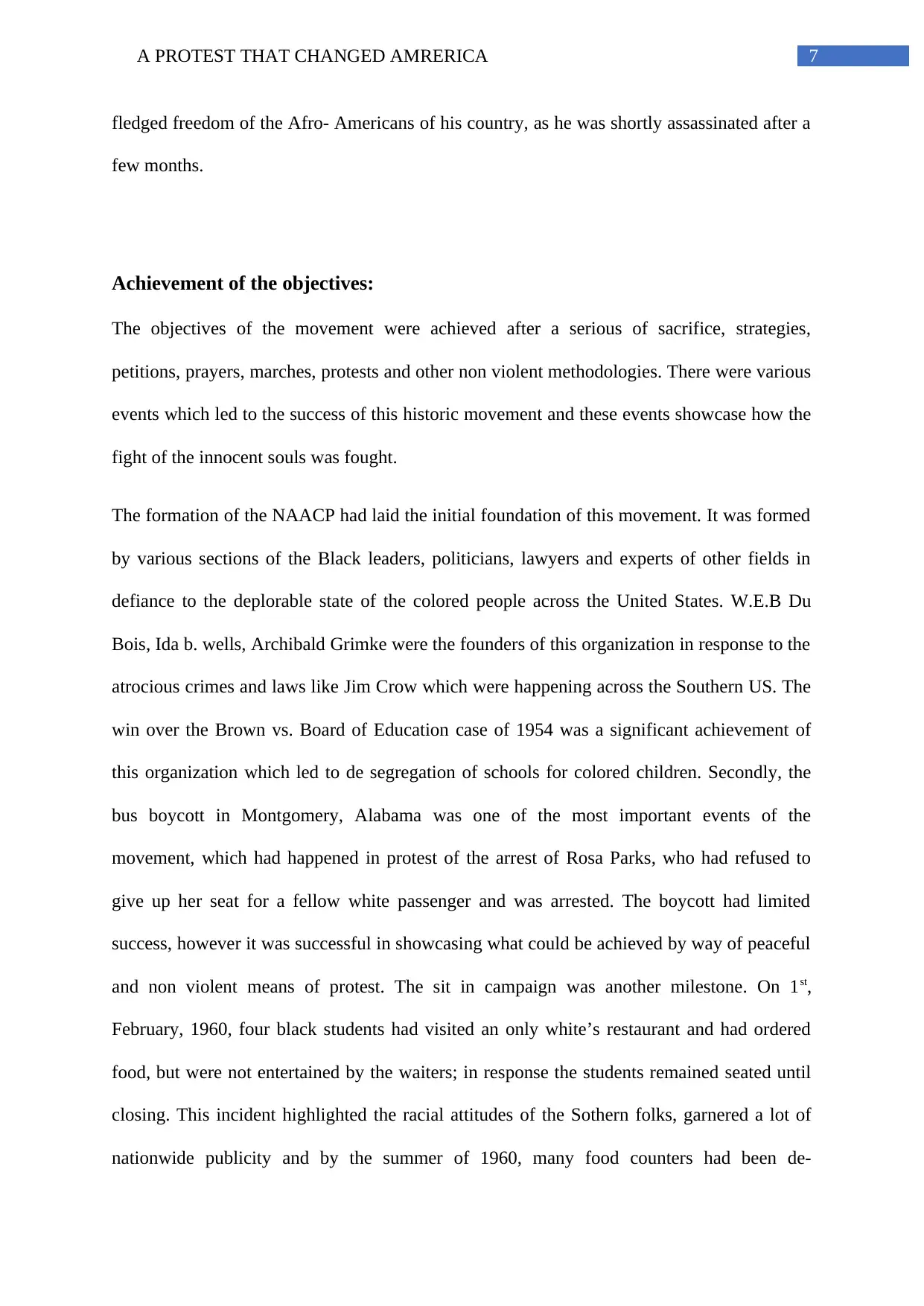
7A PROTEST THAT CHANGED AMRERICA
fledged freedom of the Afro- Americans of his country, as he was shortly assassinated after a
few months.
Achievement of the objectives:
The objectives of the movement were achieved after a serious of sacrifice, strategies,
petitions, prayers, marches, protests and other non violent methodologies. There were various
events which led to the success of this historic movement and these events showcase how the
fight of the innocent souls was fought.
The formation of the NAACP had laid the initial foundation of this movement. It was formed
by various sections of the Black leaders, politicians, lawyers and experts of other fields in
defiance to the deplorable state of the colored people across the United States. W.E.B Du
Bois, Ida b. wells, Archibald Grimke were the founders of this organization in response to the
atrocious crimes and laws like Jim Crow which were happening across the Southern US. The
win over the Brown vs. Board of Education case of 1954 was a significant achievement of
this organization which led to de segregation of schools for colored children. Secondly, the
bus boycott in Montgomery, Alabama was one of the most important events of the
movement, which had happened in protest of the arrest of Rosa Parks, who had refused to
give up her seat for a fellow white passenger and was arrested. The boycott had limited
success, however it was successful in showcasing what could be achieved by way of peaceful
and non violent means of protest. The sit in campaign was another milestone. On 1st,
February, 1960, four black students had visited an only white’s restaurant and had ordered
food, but were not entertained by the waiters; in response the students remained seated until
closing. This incident highlighted the racial attitudes of the Sothern folks, garnered a lot of
nationwide publicity and by the summer of 1960, many food counters had been de-
fledged freedom of the Afro- Americans of his country, as he was shortly assassinated after a
few months.
Achievement of the objectives:
The objectives of the movement were achieved after a serious of sacrifice, strategies,
petitions, prayers, marches, protests and other non violent methodologies. There were various
events which led to the success of this historic movement and these events showcase how the
fight of the innocent souls was fought.
The formation of the NAACP had laid the initial foundation of this movement. It was formed
by various sections of the Black leaders, politicians, lawyers and experts of other fields in
defiance to the deplorable state of the colored people across the United States. W.E.B Du
Bois, Ida b. wells, Archibald Grimke were the founders of this organization in response to the
atrocious crimes and laws like Jim Crow which were happening across the Southern US. The
win over the Brown vs. Board of Education case of 1954 was a significant achievement of
this organization which led to de segregation of schools for colored children. Secondly, the
bus boycott in Montgomery, Alabama was one of the most important events of the
movement, which had happened in protest of the arrest of Rosa Parks, who had refused to
give up her seat for a fellow white passenger and was arrested. The boycott had limited
success, however it was successful in showcasing what could be achieved by way of peaceful
and non violent means of protest. The sit in campaign was another milestone. On 1st,
February, 1960, four black students had visited an only white’s restaurant and had ordered
food, but were not entertained by the waiters; in response the students remained seated until
closing. This incident highlighted the racial attitudes of the Sothern folks, garnered a lot of
nationwide publicity and by the summer of 1960, many food counters had been de-
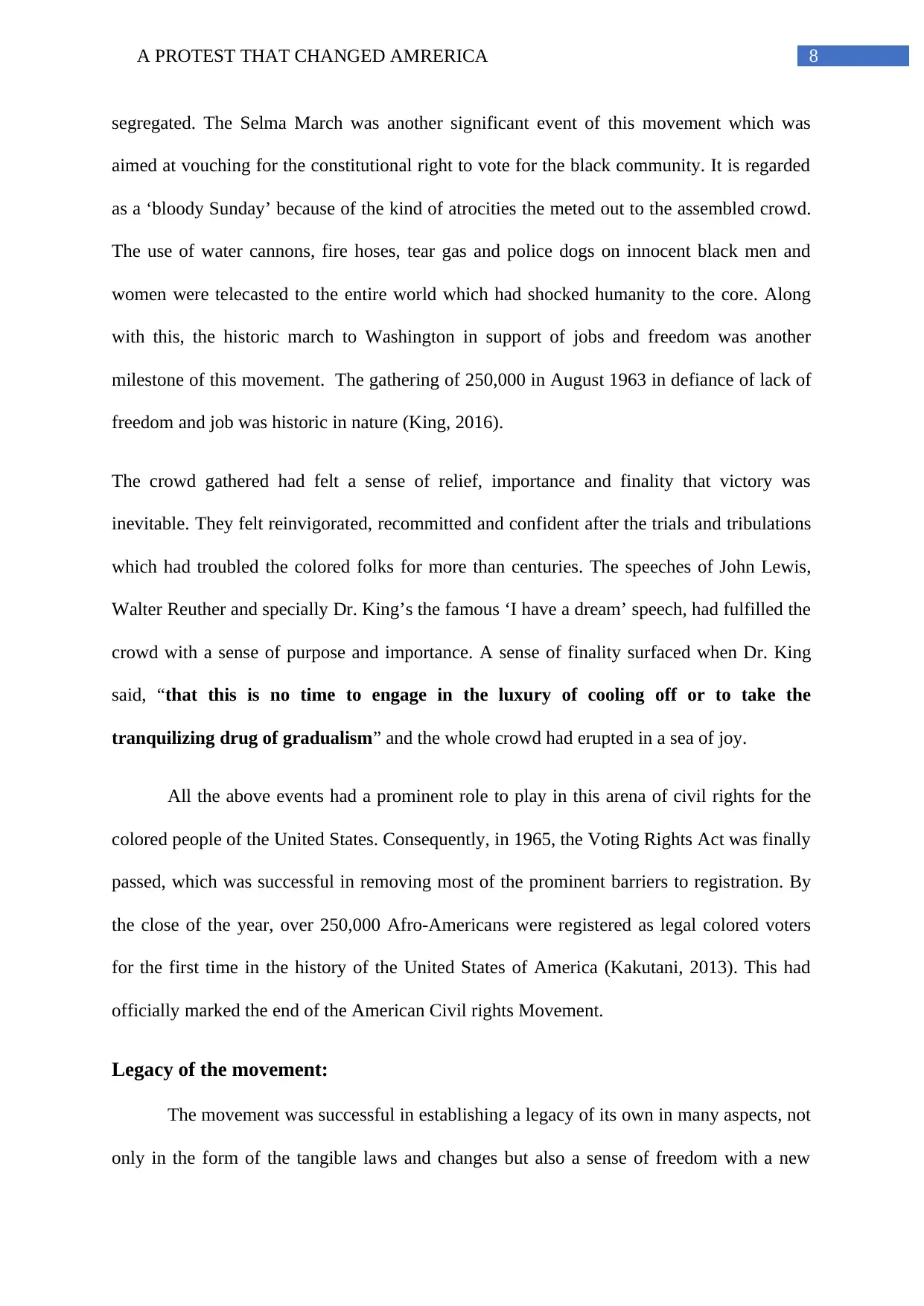
8A PROTEST THAT CHANGED AMRERICA
segregated. The Selma March was another significant event of this movement which was
aimed at vouching for the constitutional right to vote for the black community. It is regarded
as a ‘bloody Sunday’ because of the kind of atrocities the meted out to the assembled crowd.
The use of water cannons, fire hoses, tear gas and police dogs on innocent black men and
women were telecasted to the entire world which had shocked humanity to the core. Along
with this, the historic march to Washington in support of jobs and freedom was another
milestone of this movement. The gathering of 250,000 in August 1963 in defiance of lack of
freedom and job was historic in nature (King, 2016).
The crowd gathered had felt a sense of relief, importance and finality that victory was
inevitable. They felt reinvigorated, recommitted and confident after the trials and tribulations
which had troubled the colored folks for more than centuries. The speeches of John Lewis,
Walter Reuther and specially Dr. King’s the famous ‘I have a dream’ speech, had fulfilled the
crowd with a sense of purpose and importance. A sense of finality surfaced when Dr. King
said, “that this is no time to engage in the luxury of cooling off or to take the
tranquilizing drug of gradualism” and the whole crowd had erupted in a sea of joy.
All the above events had a prominent role to play in this arena of civil rights for the
colored people of the United States. Consequently, in 1965, the Voting Rights Act was finally
passed, which was successful in removing most of the prominent barriers to registration. By
the close of the year, over 250,000 Afro-Americans were registered as legal colored voters
for the first time in the history of the United States of America (Kakutani, 2013). This had
officially marked the end of the American Civil rights Movement.
Legacy of the movement:
The movement was successful in establishing a legacy of its own in many aspects, not
only in the form of the tangible laws and changes but also a sense of freedom with a new
segregated. The Selma March was another significant event of this movement which was
aimed at vouching for the constitutional right to vote for the black community. It is regarded
as a ‘bloody Sunday’ because of the kind of atrocities the meted out to the assembled crowd.
The use of water cannons, fire hoses, tear gas and police dogs on innocent black men and
women were telecasted to the entire world which had shocked humanity to the core. Along
with this, the historic march to Washington in support of jobs and freedom was another
milestone of this movement. The gathering of 250,000 in August 1963 in defiance of lack of
freedom and job was historic in nature (King, 2016).
The crowd gathered had felt a sense of relief, importance and finality that victory was
inevitable. They felt reinvigorated, recommitted and confident after the trials and tribulations
which had troubled the colored folks for more than centuries. The speeches of John Lewis,
Walter Reuther and specially Dr. King’s the famous ‘I have a dream’ speech, had fulfilled the
crowd with a sense of purpose and importance. A sense of finality surfaced when Dr. King
said, “that this is no time to engage in the luxury of cooling off or to take the
tranquilizing drug of gradualism” and the whole crowd had erupted in a sea of joy.
All the above events had a prominent role to play in this arena of civil rights for the
colored people of the United States. Consequently, in 1965, the Voting Rights Act was finally
passed, which was successful in removing most of the prominent barriers to registration. By
the close of the year, over 250,000 Afro-Americans were registered as legal colored voters
for the first time in the history of the United States of America (Kakutani, 2013). This had
officially marked the end of the American Civil rights Movement.
Legacy of the movement:
The movement was successful in establishing a legacy of its own in many aspects, not
only in the form of the tangible laws and changes but also a sense of freedom with a new
⊘ This is a preview!⊘
Do you want full access?
Subscribe today to unlock all pages.

Trusted by 1+ million students worldwide
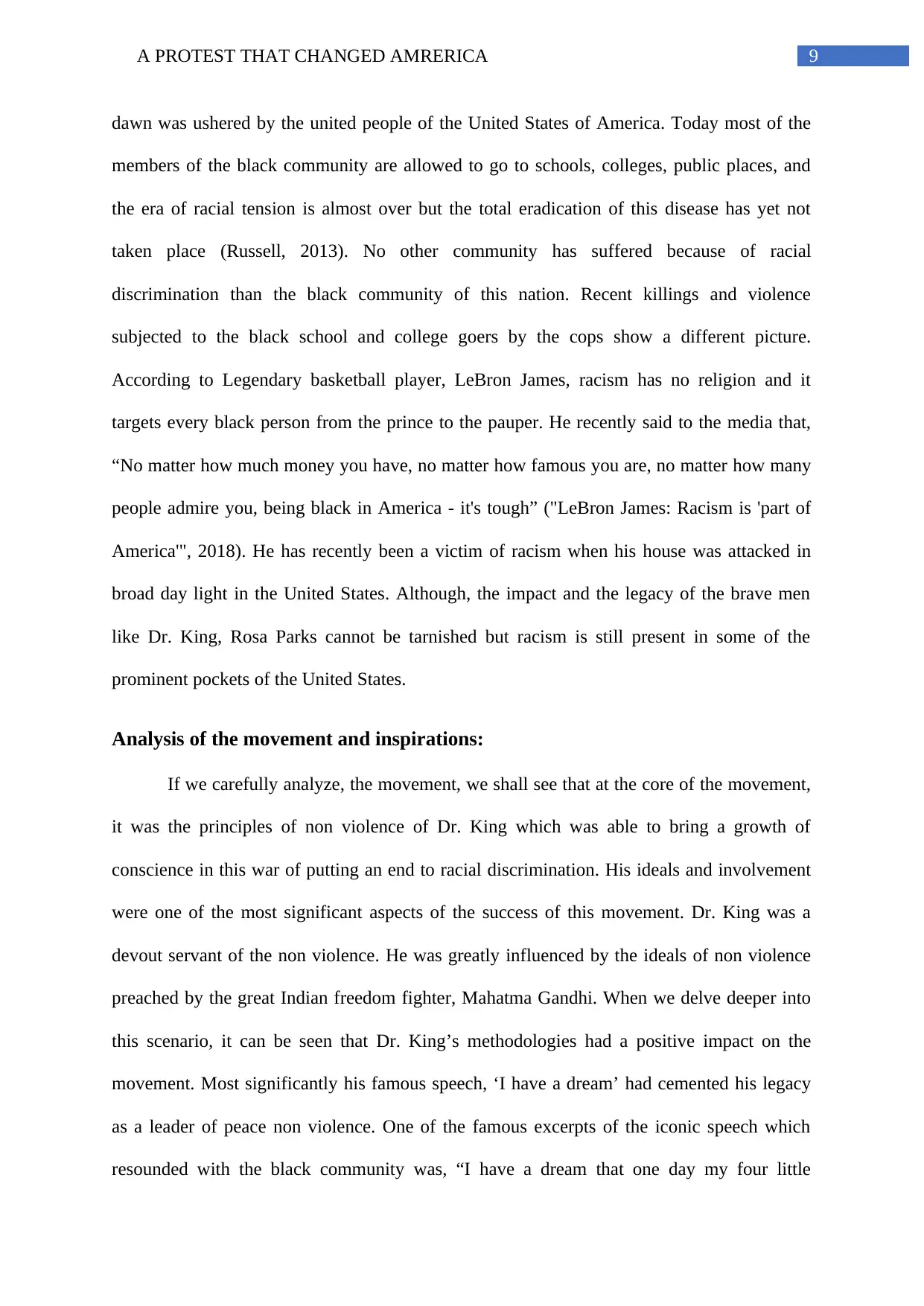
9A PROTEST THAT CHANGED AMRERICA
dawn was ushered by the united people of the United States of America. Today most of the
members of the black community are allowed to go to schools, colleges, public places, and
the era of racial tension is almost over but the total eradication of this disease has yet not
taken place (Russell, 2013). No other community has suffered because of racial
discrimination than the black community of this nation. Recent killings and violence
subjected to the black school and college goers by the cops show a different picture.
According to Legendary basketball player, LeBron James, racism has no religion and it
targets every black person from the prince to the pauper. He recently said to the media that,
“No matter how much money you have, no matter how famous you are, no matter how many
people admire you, being black in America - it's tough” ("LeBron James: Racism is 'part of
America'", 2018). He has recently been a victim of racism when his house was attacked in
broad day light in the United States. Although, the impact and the legacy of the brave men
like Dr. King, Rosa Parks cannot be tarnished but racism is still present in some of the
prominent pockets of the United States.
Analysis of the movement and inspirations:
If we carefully analyze, the movement, we shall see that at the core of the movement,
it was the principles of non violence of Dr. King which was able to bring a growth of
conscience in this war of putting an end to racial discrimination. His ideals and involvement
were one of the most significant aspects of the success of this movement. Dr. King was a
devout servant of the non violence. He was greatly influenced by the ideals of non violence
preached by the great Indian freedom fighter, Mahatma Gandhi. When we delve deeper into
this scenario, it can be seen that Dr. King’s methodologies had a positive impact on the
movement. Most significantly his famous speech, ‘I have a dream’ had cemented his legacy
as a leader of peace non violence. One of the famous excerpts of the iconic speech which
resounded with the black community was, “I have a dream that one day my four little
dawn was ushered by the united people of the United States of America. Today most of the
members of the black community are allowed to go to schools, colleges, public places, and
the era of racial tension is almost over but the total eradication of this disease has yet not
taken place (Russell, 2013). No other community has suffered because of racial
discrimination than the black community of this nation. Recent killings and violence
subjected to the black school and college goers by the cops show a different picture.
According to Legendary basketball player, LeBron James, racism has no religion and it
targets every black person from the prince to the pauper. He recently said to the media that,
“No matter how much money you have, no matter how famous you are, no matter how many
people admire you, being black in America - it's tough” ("LeBron James: Racism is 'part of
America'", 2018). He has recently been a victim of racism when his house was attacked in
broad day light in the United States. Although, the impact and the legacy of the brave men
like Dr. King, Rosa Parks cannot be tarnished but racism is still present in some of the
prominent pockets of the United States.
Analysis of the movement and inspirations:
If we carefully analyze, the movement, we shall see that at the core of the movement,
it was the principles of non violence of Dr. King which was able to bring a growth of
conscience in this war of putting an end to racial discrimination. His ideals and involvement
were one of the most significant aspects of the success of this movement. Dr. King was a
devout servant of the non violence. He was greatly influenced by the ideals of non violence
preached by the great Indian freedom fighter, Mahatma Gandhi. When we delve deeper into
this scenario, it can be seen that Dr. King’s methodologies had a positive impact on the
movement. Most significantly his famous speech, ‘I have a dream’ had cemented his legacy
as a leader of peace non violence. One of the famous excerpts of the iconic speech which
resounded with the black community was, “I have a dream that one day my four little
Paraphrase This Document
Need a fresh take? Get an instant paraphrase of this document with our AI Paraphraser
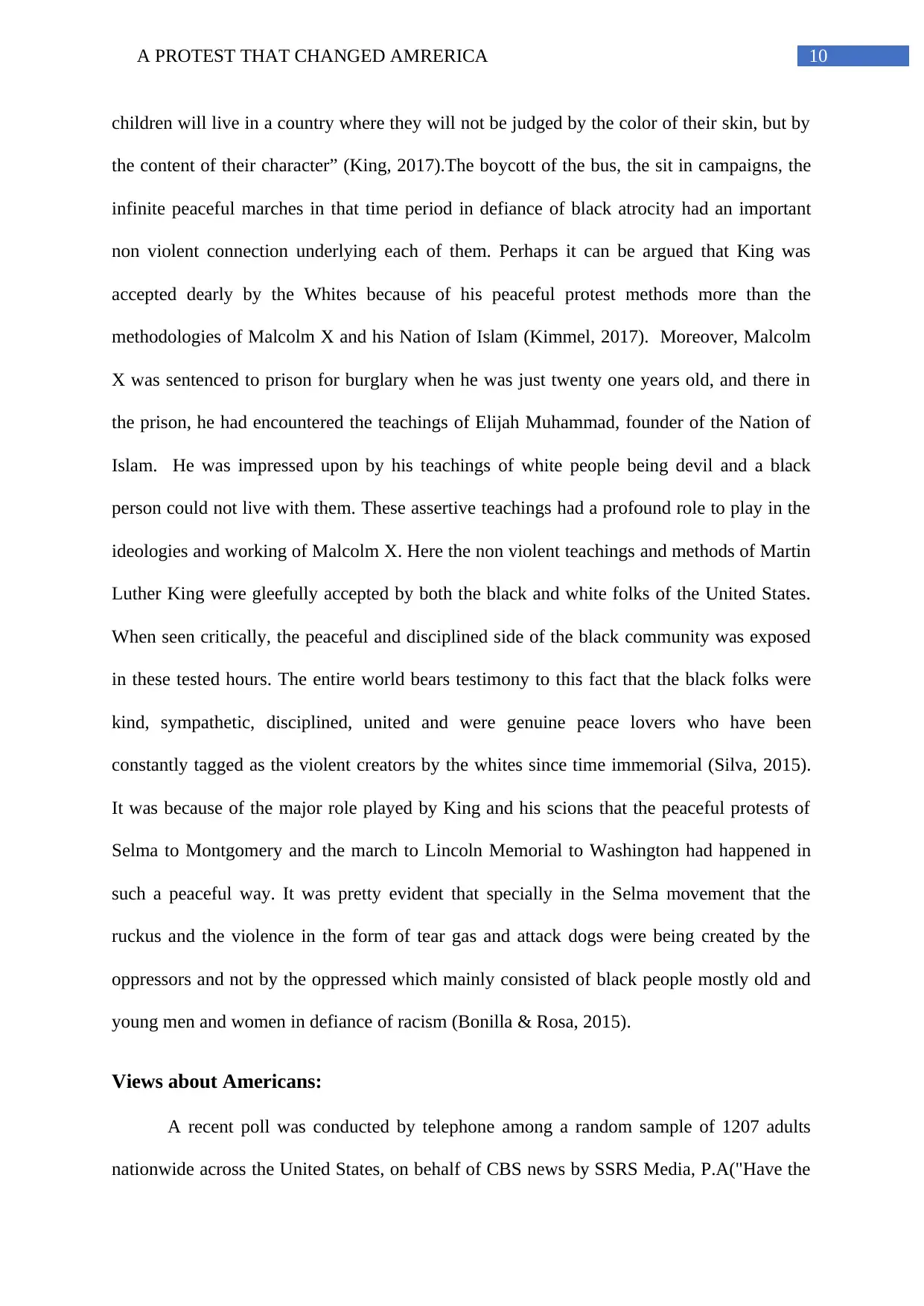
10A PROTEST THAT CHANGED AMRERICA
children will live in a country where they will not be judged by the color of their skin, but by
the content of their character” (King, 2017).The boycott of the bus, the sit in campaigns, the
infinite peaceful marches in that time period in defiance of black atrocity had an important
non violent connection underlying each of them. Perhaps it can be argued that King was
accepted dearly by the Whites because of his peaceful protest methods more than the
methodologies of Malcolm X and his Nation of Islam (Kimmel, 2017). Moreover, Malcolm
X was sentenced to prison for burglary when he was just twenty one years old, and there in
the prison, he had encountered the teachings of Elijah Muhammad, founder of the Nation of
Islam. He was impressed upon by his teachings of white people being devil and a black
person could not live with them. These assertive teachings had a profound role to play in the
ideologies and working of Malcolm X. Here the non violent teachings and methods of Martin
Luther King were gleefully accepted by both the black and white folks of the United States.
When seen critically, the peaceful and disciplined side of the black community was exposed
in these tested hours. The entire world bears testimony to this fact that the black folks were
kind, sympathetic, disciplined, united and were genuine peace lovers who have been
constantly tagged as the violent creators by the whites since time immemorial (Silva, 2015).
It was because of the major role played by King and his scions that the peaceful protests of
Selma to Montgomery and the march to Lincoln Memorial to Washington had happened in
such a peaceful way. It was pretty evident that specially in the Selma movement that the
ruckus and the violence in the form of tear gas and attack dogs were being created by the
oppressors and not by the oppressed which mainly consisted of black people mostly old and
young men and women in defiance of racism (Bonilla & Rosa, 2015).
Views about Americans:
A recent poll was conducted by telephone among a random sample of 1207 adults
nationwide across the United States, on behalf of CBS news by SSRS Media, P.A("Have the
children will live in a country where they will not be judged by the color of their skin, but by
the content of their character” (King, 2017).The boycott of the bus, the sit in campaigns, the
infinite peaceful marches in that time period in defiance of black atrocity had an important
non violent connection underlying each of them. Perhaps it can be argued that King was
accepted dearly by the Whites because of his peaceful protest methods more than the
methodologies of Malcolm X and his Nation of Islam (Kimmel, 2017). Moreover, Malcolm
X was sentenced to prison for burglary when he was just twenty one years old, and there in
the prison, he had encountered the teachings of Elijah Muhammad, founder of the Nation of
Islam. He was impressed upon by his teachings of white people being devil and a black
person could not live with them. These assertive teachings had a profound role to play in the
ideologies and working of Malcolm X. Here the non violent teachings and methods of Martin
Luther King were gleefully accepted by both the black and white folks of the United States.
When seen critically, the peaceful and disciplined side of the black community was exposed
in these tested hours. The entire world bears testimony to this fact that the black folks were
kind, sympathetic, disciplined, united and were genuine peace lovers who have been
constantly tagged as the violent creators by the whites since time immemorial (Silva, 2015).
It was because of the major role played by King and his scions that the peaceful protests of
Selma to Montgomery and the march to Lincoln Memorial to Washington had happened in
such a peaceful way. It was pretty evident that specially in the Selma movement that the
ruckus and the violence in the form of tear gas and attack dogs were being created by the
oppressors and not by the oppressed which mainly consisted of black people mostly old and
young men and women in defiance of racism (Bonilla & Rosa, 2015).
Views about Americans:
A recent poll was conducted by telephone among a random sample of 1207 adults
nationwide across the United States, on behalf of CBS news by SSRS Media, P.A("Have the
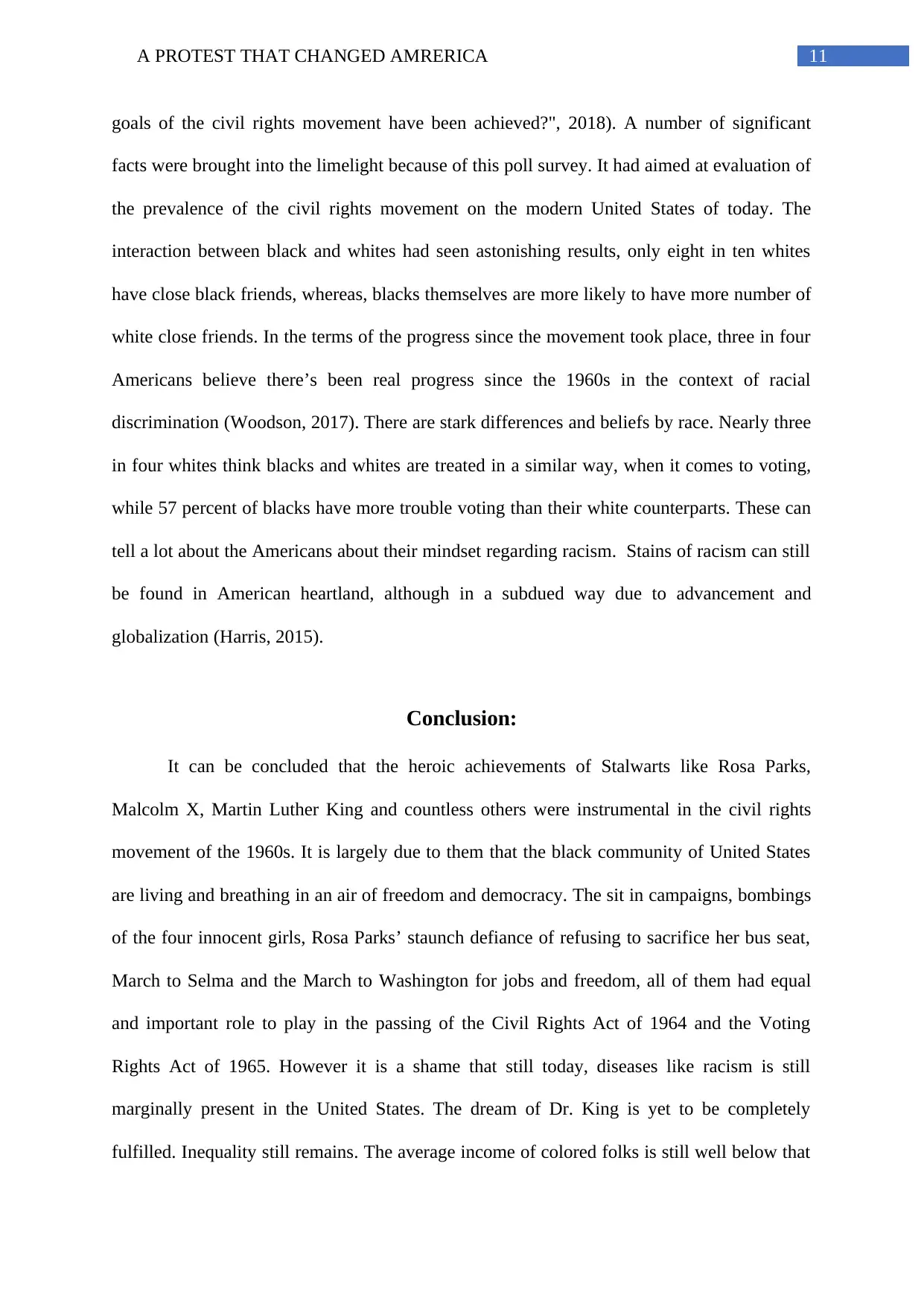
11A PROTEST THAT CHANGED AMRERICA
goals of the civil rights movement have been achieved?", 2018). A number of significant
facts were brought into the limelight because of this poll survey. It had aimed at evaluation of
the prevalence of the civil rights movement on the modern United States of today. The
interaction between black and whites had seen astonishing results, only eight in ten whites
have close black friends, whereas, blacks themselves are more likely to have more number of
white close friends. In the terms of the progress since the movement took place, three in four
Americans believe there’s been real progress since the 1960s in the context of racial
discrimination (Woodson, 2017). There are stark differences and beliefs by race. Nearly three
in four whites think blacks and whites are treated in a similar way, when it comes to voting,
while 57 percent of blacks have more trouble voting than their white counterparts. These can
tell a lot about the Americans about their mindset regarding racism. Stains of racism can still
be found in American heartland, although in a subdued way due to advancement and
globalization (Harris, 2015).
Conclusion:
It can be concluded that the heroic achievements of Stalwarts like Rosa Parks,
Malcolm X, Martin Luther King and countless others were instrumental in the civil rights
movement of the 1960s. It is largely due to them that the black community of United States
are living and breathing in an air of freedom and democracy. The sit in campaigns, bombings
of the four innocent girls, Rosa Parks’ staunch defiance of refusing to sacrifice her bus seat,
March to Selma and the March to Washington for jobs and freedom, all of them had equal
and important role to play in the passing of the Civil Rights Act of 1964 and the Voting
Rights Act of 1965. However it is a shame that still today, diseases like racism is still
marginally present in the United States. The dream of Dr. King is yet to be completely
fulfilled. Inequality still remains. The average income of colored folks is still well below that
goals of the civil rights movement have been achieved?", 2018). A number of significant
facts were brought into the limelight because of this poll survey. It had aimed at evaluation of
the prevalence of the civil rights movement on the modern United States of today. The
interaction between black and whites had seen astonishing results, only eight in ten whites
have close black friends, whereas, blacks themselves are more likely to have more number of
white close friends. In the terms of the progress since the movement took place, three in four
Americans believe there’s been real progress since the 1960s in the context of racial
discrimination (Woodson, 2017). There are stark differences and beliefs by race. Nearly three
in four whites think blacks and whites are treated in a similar way, when it comes to voting,
while 57 percent of blacks have more trouble voting than their white counterparts. These can
tell a lot about the Americans about their mindset regarding racism. Stains of racism can still
be found in American heartland, although in a subdued way due to advancement and
globalization (Harris, 2015).
Conclusion:
It can be concluded that the heroic achievements of Stalwarts like Rosa Parks,
Malcolm X, Martin Luther King and countless others were instrumental in the civil rights
movement of the 1960s. It is largely due to them that the black community of United States
are living and breathing in an air of freedom and democracy. The sit in campaigns, bombings
of the four innocent girls, Rosa Parks’ staunch defiance of refusing to sacrifice her bus seat,
March to Selma and the March to Washington for jobs and freedom, all of them had equal
and important role to play in the passing of the Civil Rights Act of 1964 and the Voting
Rights Act of 1965. However it is a shame that still today, diseases like racism is still
marginally present in the United States. The dream of Dr. King is yet to be completely
fulfilled. Inequality still remains. The average income of colored folks is still well below that
⊘ This is a preview!⊘
Do you want full access?
Subscribe today to unlock all pages.

Trusted by 1+ million students worldwide
1 out of 15
Related Documents
Your All-in-One AI-Powered Toolkit for Academic Success.
+13062052269
info@desklib.com
Available 24*7 on WhatsApp / Email
![[object Object]](/_next/static/media/star-bottom.7253800d.svg)
Unlock your academic potential
Copyright © 2020–2025 A2Z Services. All Rights Reserved. Developed and managed by ZUCOL.





